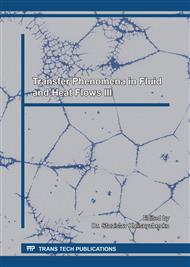[1]
M. Chaker and C. B. Meher-Homji, Gas turbine power augmentation: parametric study relating to fog droplet size and its influence on evaporative efficiency, Journal of Engineering for Gas Turbines and Power, vol. 133, p.092001, (2011).
DOI: 10.1115/1.4002883
Google Scholar
[2]
M. Chaker, C. B. Meher-Homji, and T. Mee, Inlet Fogging of Gas Turbine Engines: Part A—Fog Droplet Thermodynamics, Heat Transfer and Practical Considerations, in ASME Turbo Expo 2002: Power for Land, Sea, and Air, 2002, pp.413-428.
DOI: 10.1115/gt2002-30562
Google Scholar
[3]
M. Chaker, C. B. Meher-Homji, and T. Mee, Inlet fogging of gas turbine engines—Part III: Fog behavior in inlet ducts, computational fluid dynamics analysis, and wind tunnel experiments, Journal of engineering for gas turbines and power, vol. 126, pp.571-580, (2004).
DOI: 10.1115/1.1712983
Google Scholar
[4]
S. W. Lee, S. U. Kim, and K. H. Kim, Aerodynamic performance of winglets covering the tip gap inlet in a turbine cascade, International Journal of Heat and Fluid Flow, vol. 34, pp.36-46, (2012).
DOI: 10.1016/j.ijheatfluidflow.2011.11.008
Google Scholar
[5]
Q. Zheng, Y. Sun, S. Li, and Y. Wang, Thermodynamic analyses of wet compression process in the compressor of gas turbine, in ASME Turbo Expo 2002: Power for Land, Sea, and Air, 2002, pp.487-496.
DOI: 10.1115/gt2002-30590
Google Scholar
[6]
Q. Zheng and M. Li, Wet Compression System Stability Analysis: Part II—Simulations and Bifurcation Analysis, in ASME Turbo Expo 2004: Power for Land, Sea, and Air, 2004, pp.713-721.
DOI: 10.1115/gt2004-54020
Google Scholar
[7]
L. Sun, Q. Zheng, Y. Li, and R. Bhargava, Understanding effects of wet compression on separated flow behavior in an axial compressor stage using CFD analysis, Journal of Turbomachinery, vol. 133, p.031026, (2011).
DOI: 10.1115/1.4003003
Google Scholar
[8]
L. Sun, Q. Zheng, Y. Li, M. Luo, and R. K. Bhargava, Numerical Simulation of a Complete Gas Turbine Engine With Wet Compression, Journal of Engineering for Gas Turbines and Power, vol. 135, p.012002, (2013).
DOI: 10.1115/1.4007366
Google Scholar
[9]
G. Montalvo-Catano and W. F. O'Brien, Performance Modeling of a Power Generation Gas Turbine With Wet Compression, in ASME 2011 Turbo Expo: Turbine Technical Conference and Exposition, 2011, pp.665-674.
DOI: 10.1115/gt2011-46584
Google Scholar
[10]
M. R. Sexton, H. B. Urbach, and D. T. Knauss, Evaporative compressor cooling for NOx suppression and enhanced engine performance for naval gas turbine propulsion plants, in ASME 1998 International Gas Turbine and Aeroengine Congress and Exhibition, 1998, pp. V002T03A015-V002T03A015.
DOI: 10.1115/98-gt-332
Google Scholar
[11]
M. Jonsson and J. Yan, Humidified gas turbines—a review of proposed and implemented cycles, Energy, vol. 30, pp.1013-1078, (2005).
DOI: 10.1016/j.energy.2004.08.005
Google Scholar
[12]
A. White and A. Meacock, An evaluation of the effects of water injection on compressor performance, in ASME Turbo Expo 2003, collocated with the 2003 International Joint Power Generation Conference, 2003, pp.181-189.
DOI: 10.1115/gt2003-38237
Google Scholar
[13]
T. Wang and J. R. Khan, Overspray and Interstage Fog Cooling in Compressor Using Stage-Stacking Scheme: Part 1—Development of Theory and Algorithm, in ASME Turbo Expo 2008: Power for Land, Sea, and Air, 2008, pp.99-109.
DOI: 10.1115/gt2008-50322
Google Scholar
[14]
T. Wang and J. R. Khan, Overspray and Interstage Fog Cooling in Compressor Using Stage-Stacking Scheme: Part 2—Case Study, in ASME Turbo Expo 2008: Power for Land, Sea, and Air, 2008, pp.111-121.
DOI: 10.1115/gt2008-50323
Google Scholar
[15]
C. Matz, G. Cataldi, W. Kappis, G. Mundinger, S. Bischoff, E. Helland, et al., Prediction of Evaporative Effects Within the Blading of an Industrial Axial Compressor, Journal of Turbomachinery, vol. 132, p.041013, (2010).
DOI: 10.1115/1.3149285
Google Scholar
[16]
Z. Mustafa, P. Pilidis, J. A. A. Teixeira, and K. A. Ahmad, CFD aerodynamic investigation of air-water trajectories on rotor-stator blade of an axial compressor for online washing, in ASME Turbo Expo 2006: Power for Land, Sea, and Air, 2006, pp.1385-1394.
DOI: 10.1115/gt2006-90745
Google Scholar
[17]
C. Hartel and P. Pfeiffer, Model analysis of high-fogging effects on the work of compression, in ASME Turbo Expo 2003, collocated with the 2003 International Joint Power Generation Conference, 2003, pp.689-698.
DOI: 10.1115/gt2003-38117
Google Scholar
[18]
E. Ulrichs and F. Joos, Experimental investigations of the influence of waterdroplets in compressor cascades, in ASME Turbo Expo 2006: Power for Land, Sea, and Air, 2006, pp.221-230.
DOI: 10.1115/gt2006-90411
Google Scholar
[19]
T. Nikolaidis, Water ingestion effects on gas turbine engine performance, (2008).
Google Scholar
[20]
W. W. Copenhaver, E. R. Mayhew, and C. Hah, The effect of tip clearance on a swept transonic compressor rotor, in ASME 1994 International Gas Turbine and Aeroengine Congress and Exposition, 1994, pp. V001T01A124-V001T01A124.
DOI: 10.1115/94-gt-363
Google Scholar
[21]
D. W. Thompson, P. I. King, C. Hah, and D. C. Rabe, Experimental and computational investigation of stepped tip gap effects on the flowfield of a transonic axial-flow compressor rotor, in ASME 1998 International Gas Turbine and Aeroengine Congress and Exhibition, 1998, pp. V001T01A026-V001T01A026.
DOI: 10.1115/98-gt-090
Google Scholar
[22]
M. Luo, Q. Zheng, L. Sun, Q. Deng, S. Li, C. Liu, et al., The Numerical Simulation of Inlet Fogging Effects on the Stable Range of a Transonic Compressor Stage, in ASME 2011 Turbo Expo: Turbine Technical Conference and Exposition, 2011, pp.609-630.
DOI: 10.1115/gt2011-46124
Google Scholar
[23]
Crowe, Clayton, T., M. Sommerfeld, and Yutaka Tsuji, Multiphase Flows with Droplets and Particles, CRC Press, (1998).
DOI: 10.1080/07373939908917667
Google Scholar
[24]
C. Bai and A. Gosman, Development of methodology for spray impingement simulation, SAE Technical Paper 0148-7191, (1995).
DOI: 10.4271/950283
Google Scholar
[25]
R. D. Moore and L. Reid, Performance of single-stage axial-flow transonic compressor with rotor and stator aspect ratios of 1. 63 and 1. 78, respectively, and with design pressure ratio of 1. 82, (1982).
Google Scholar


